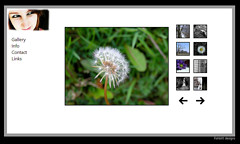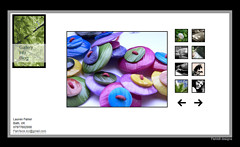Developing an assessment portfolio/Possible Formats
Return to Developing an assessment portfolio
| Work in progress, expect frequent changes. Help and feedback is welcome. See discussion page. |
Contents
- 1 Preparing your eportfolio as an assessment portfolio for Practice Context
- 2 Why have an ePortfolio?
Preparing your eportfolio as an assessment portfolio for Practice Context
You are encouraged to choose a digital portfolio format that suits you best. Evidence can be collated electronically in many media formats: text, images, audio, video, websites etc. You can use a combination of digital and paper (and then scan this material for insertion in the eportfolio). You must ensure that the facilitator and/or assessor can easily access all the material in your portfolio and that you follow the requirements for the portfolio. You are encouraged to use a format that can be shared with other participants. Encouragement from peers and their feedback can be very motivating. Of course this means that you need to make time to encourage other participants with their portfolio work. it can also give you ideas and stimulate discussion.
- Four clearly identified sections are needed in your portfolio for the following subject areas:
- Digital Citizenship
- Reflective Practice
- Biculturalism
- Professionalism and Work Context
- Include a reflective narrative (written or spoken) in each section that:
- explores what you have learned and the relevance of this to your work
- includes discussion of how your new learning has impacted on your practice and influenced future actions you may take
- is supported with educational literature and other forms of information
- is supported with your choice of evidence, that is authentic, current, sufficient and relevant.
Please submit or notify your facilitator when each section is ready for formative feedback or marking - this is encouraged, you do not need to wait until near the end of the course and submit all sections together.
Why have an ePortfolio?
- Accessibility: artefacts (evidence) can be reproduced more easily and cheaply and disseminated more widely to people in different locations.
- Portability: easier to transport - no more heavy boxes and folders.
- Creativity: a wider variety of interactive media can be included - text, video, images, audio, hyperlinks to other information.
- Community: share information and ideas more easily and widely.
- Capability: develop your digital citizenship (also digital information literacy).
- Technological development - enhance your self-efficacy in using technologies and extend technical skills.
- Compile: put together evidence of your learning journey.
If you don't already have one - the portfolio you develop during your studies will make a great start to your Teaching Portfolio - a tool for tracking your professional development.
Using an ePortfolio) for your GDTE study
For the Graduate Certificate in Tertiary Learning and Teaching a digital portfolio can be used as a:
- A Learning Portfolio
- where you collect material and reflect on what you are learning as you progress. This can be both a journal where you reflect on your understandings, and a repository of information (articles, websites, etc.) that you collect. Key items from this portfolio are selected for the Assessment portfolio.
- An Assessment Portfolio
- contains a selection of evidence and a narrative (story) and reflective discussion about key learning and how you will use this new knowledge in your teaching practice. Also include your reflections on others' perspectives from the research literature and other information sources and form an argument for your point of view.
It is particularly valuable if you make your work available to others in the class as you progress as it gives you the opportunity to communicate, collaborate and share ideas and also receive peer feedback. A mix of written material and other media (images, audio, video, diagrams etc) can be used as evidence in your portfolio. You can be as creative as you wish.
An e-portfolio can be as simple as an electronic document with the appropriate evidence attached, through to sophisticated e-portfolio proprietary platforms. Some people use wikis, blogs orGoogleApps. The choices are vast so start exploring. For more information read on.
|
Getting Started
- Steps in compiling a digital assessment portfolio (ePortfolio)
- Decide on a design for the portfolio – colours, metaphor, headings, ‘look and feel’, and media etc.
- Select a platform or platforms, and additional tools to be used to manage information, share evidence and to interact with others in class.
- The portfolio activities for each topic will guide in developing evidence.
- Please use the Three-Step Reflective Framework to structure your reflective writing (a separate template you can type in is provided on Moodle).
NB: Participants who are Otago Polytechnic staff, please note that there is not a proprietary platform that the organisation currently uses or provides support for so you are encouraged to look at freely available forms of e-portfolios.
Examples of platforms to try
1. Google Sites - set up or use your Google account. Simple and easy to use. Lots of templates to choose from including an ePortfolio template.
- Click Create (red button). Select the blank template.
- Name your site. (Be sure to write down the website address (URL) so you don't lose your lovely new porfolio.)
- Select a theme.
- You are 'good to go' and can start adding pages and artefacts (information, images, text, files, etc.)
- A good place to start is with your introduction - something about yourself and your work, and whatever else you wish to share. Personalising the introduction with a picture of yourself and some personal information sets a friendly tone.
2. Box - file creation and storage using folders. You can create Google docs and Microsoft files.
3. Evernote - note taking and sharing utility. Great for compiling a mix of media into a series of notes and folders.
4. Wix - a free website builder. Lots of templates to choose from.
5. Pathbrite. Being trialed by Otago Polytechnic - free trial accounts available.
A sample of different platforms to show you some of the features that can be useful in an eportfolio. Every eportfolio will be different.
|
Other options - Using Blogs and Wikis
- A blog is the ideal platform
- for writing about your thinking and learning in the course, and sharing it. When your blog is connected to other platforms, for example, Google Sites or a wiki you can build a formidable portfolio of evidence and reflections about your practice. Google sites enables a more structured portfolio than a blog and also enables files to be stored there.
- wikis are designed to be collaborative; but you can also use them for individual work. They work really well if you are compiling something with other students for a project. Examples include
All these sites have options for privacy if you do not wish to have an open portfolio, and you will need to specifically invite the class members and the lecturer to view your portfolio. The choice of platform depends on the type of portfolio you wish to develop.
Reflective writing in your portfolio
Please use the Three-Step Reflective Framework and template to guide and structure your reflections and writing in your Learning Portfolio. (This was developed during Bronwyn Hegarty's (2011) Doctorate research.)
A good example of how to use the Reflective Framework can be found on Christine's blog post about using smartboards.
Setting up a blog
If using a blog, please do the following:
- View the video (28.52 min) How to Set Up Your Blog in Blogger by Jen Jonson - good clear explanation for teachers covering lots of features.
- Look at - Help in getting started with blogs to set up a blog.
- Blogging Handbook for tips on writing on a blog.
- Don't forget to share the link to your blog as instructed!
Using images on your blog
There are a few easy steps you need to take when searching for images for use on your blog. If you are not using your own images, you need to be careful not to breach copyright regulations. Therefore, it is best to search for images with Creative Commons licensing.
- Search Google (image) or Flickr (image) at: http://search.creativecommons.org/
- Check the images you choose have Some Rights Reserved licensing NOT All Rights Reserved.
- Give attribution to the photographer and the image.
- To do this, put the photographer's name and the name of the image beneath your image and add the hyperlink to the image - it can be in a smaller font than the rest of the text.
- Grab the URL for the photographer and embed it in the name - ask if you need help with images.
- Remember to leave a comment for the photographer to inform him or her how you are using the image (You need to be logged in to do this.)
Examples of blogs
These blogs were kept by teachers in other courses:
- Sarah Stewart's introduction to the Flexible Learning class.
- A blog post by Raewyn Lesa called: Is flexible learning a new concept?
Subscribing to other peoples' blogs
It will save you time and make it faster and more efficient to read others' blog posts when you set up a Reader for accessing blog RSS feeds.
- If they enable email subscribing take the opportunity, and you will receive an email when new posts are made.
- When leaving a comment on someone's blog, make sure you subscribe to email follow up comments. That way you can more easily join in the 'blog conversations'.




